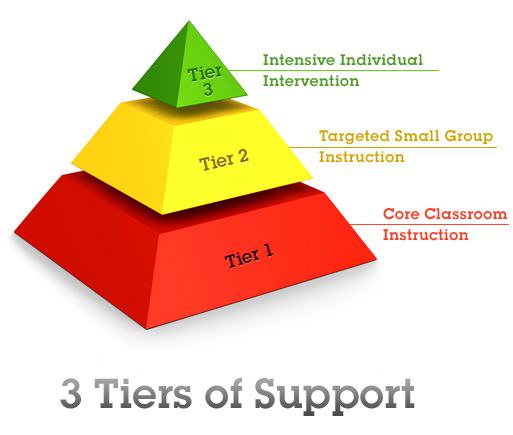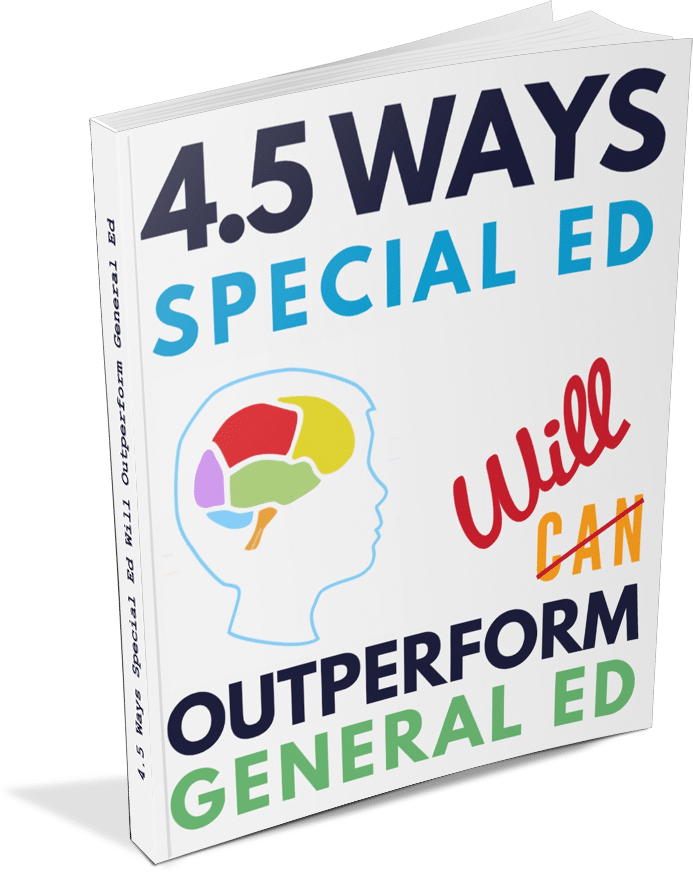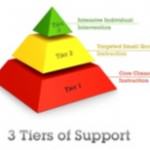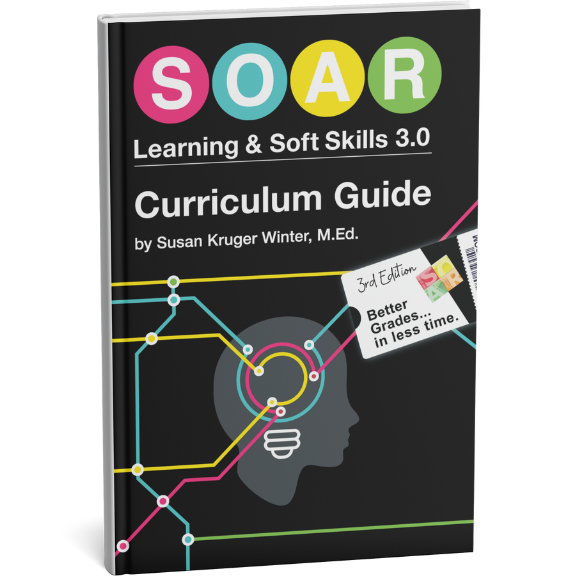RTI Tier 2 Interventions:
Elements of Effective Intervention Lessons

Assessments (formal and anecdotal) from Tier 1 instruction help teachers identify students needing more support. In a targeted RTI Tier 2 interventions group, it’s extremely important that instruction is not s-l-o-w-e-r. Or, LOUDER.
If students didn’t understand the concepts in Tier 1 instruction, they need a totally different approach. Small groups are ideal settings for changing the tempo of instruction.
Elements of Effective (Intervention) Lessons
The following strategies are really best-practices for all instruction, but they will help you make the most of your RTI Tier 2 intervention time:
1. Short, frequent sessions. Take a cue from the caveman and keep it quick.
My son has ADHD and “severe dyslexia.” After a long journey, we finally got a diagnosis and moved to a new school at the tail-end of 1st grade. As the dust was settling that first summer, he had a LOT of catching up to do! He had just missed the most critical year of literacy instruction; it was tempting to fill every available hour. His school provided summer school that met 3 hours/day, 3 days/week. But, I chose a different path.
I hired our babysitter to tutor him 1 hour/day, 5 days a week. I felt that one hour a day, five days a week, would be optimal; Mark would get a lot of practice, but still have plenty of time to play, create, and do all of the things that make his brain explode with excitement! That proved to be the right path. He was reading “at grade level” within a few short months.
Our brains were designed for primitive survival. In the wild, there is no such thing as intense, sustained attention for a long period of time. There is only survival. The “intense, sustained attention” is only needed in short bursts. In fact, exercise-science is confirming this is true for our bodies, as well. Research shows that short bursts of cardio-vascular exercise are healthier than long, sustained sessions.
Humans’ environments have evolved light-years since we were living in caves. But, our brains have not evolved nearly as much. Our brains still very much prefer short sessions. The key to master is short, frequent, sessions.
2. Alternate activities. Change it up to keep the brain engaged.
Back to the story about my son… (Sorry, to drone on about my son, but I think stories are most effective…)
That summer, I chose to focus on his top 3 “bottlenecks” for learning: decoding/phonics, handwriting, and basic math facts. (All three of these functions are a result of a “working memory” deficit.) I chose three programs to help us target each of these three areas. During every tutoring session, my son spent 20 minutes working with three programs: a decoding/spelling program, a carefully chosen handwriting program (Handwriting Without Tears is far-and-away the best way to teach handwriting), and a math-facts computer game.
Each program required a different “output”: The handwriting session was a paper-and-pencil drill. The spelling/decoding program was “hands-on” with magnetic letter tiles. The math program gave him a chance to work on the computer. Consequently, each 20-minute session was using different parts of his brain.
Changing the “output” or “modality” of instruction is key to avoiding the “s-l-0-w-e-r and LOUDER” trap that is so common in intervention.
3. Keep the Pace Moving.
In our media society, the pace has to be fast to keep all learners engaged. Learners who need RTI Tier 2 interventions, however, are more likely to have attention challenges; their minds are more likely to wander, get bored, and loose motivation quickly.
To handle this pressure, let a timer lead. Timers are neutral third parties; students don’t argue with a timer. Timers also add a sense of urgency, which boosts students’ engagement.
Timers also keep us on pace. I know I’m guilty of turning a “mini-lesson” into a waaaay-too-long lecture. I started using timers to challenge myself to keep “mini-lessons” mini.
This is a good time to remind ourselves that we must expect the bad days. Avoid the power-struggles. Avoid self-imposed guilt. Let bad days be. The timer will ensure that the torture does not last too long… for your students and for you!
One word of caution: you don’t always want to push the pace. If a student is “in the zone,” happily making progress, and doesn’t want to stop, let him go. During these periods, emotions are positive and the brain is ripe for learning! Take advantage whenever you can.
4. Use the Power of Peer Discussions
Peer pressure is incredibly powerful, and that’s not always a bad thing. A substance abuse counselor once told me, “If I am having trouble reaching an adolescent in a one-on-one therapy session, I will send them to group therapy. There is no greater influence in an adolescent’s life than their peers, and group therapy is very successful in reaching our toughest kids!”
If group discussions can help teens break drug addictions, imagine the impact they can have on RTI Tier 2 interventions?
When students are hesitant, reluctant, and unsure if they can trust you, peers can have a big influence in turning that trust around! See my article, Make Your Job Easier by Harnessing Positive Peer Pressure, included in the appendix, for specific guidelines on hosting effective classroom discussions.
5. Sit. Stand. Lie on the floor.
Whatever it takes. Over the years, I have had many parents and teachers ask me to tell their child (or students) that they should be sitting at a table or desk to learn best.
Sorry. I can’t do that.
There are times when a specific “posture” is important. For example, working on a flat surface when writing or tracking text for reading allows the hands to relax and work most efficiently with the eyes. However, in both of these situations, the child could be standing, or kneeling at a low table, or sitting on a large ball, or using a lap desk. My son went through his battery of tests, it was over the course of several visits. Each time, the evaluators noted that he preferred to stand and actually performed better while standing.
The body should be free to do what the body needs to do. Afterall, if the body is not comfortable, it will block the pathways to learning.
Success with RTI Tier 2 Interventions
Making students feel “safe” is the primary goal for all learning environments. RTI Tier 2 interventions are an extra opportunity to connect with a student and provide some personal attention, feedback, and encouragement.
If all has been successful with your targeted intervention group(s), students will return to the classroom for Tier 1 instruction, along with their peers. Maybe they’ll come back to another Tier 2 session in the future. Maybe they won’t.
If challenges continue, then RTI Tier 3 interventions are the next step. They are targeted, 1-1 instructional sessions. You can find more information on Tier 3 at the link below.
To your students’ success!
Susan Kruger, M.Ed.
Author of SOAR® Learning & Soft Skills
Founder of www.studyskills.com
RTI: Response to Intervention Menu
See more information on RTI: Response to Intervention at the links below:
- Introduction to RTI: Response to Intervention
- Tier 1 Interventions: The Small Set of Skills with 80% Impact
- Tier 2 Interventions: Elements of Effective Intervention Lessons
- Tier 3 Interventions: Take a Step Back Before Going Forward
Get Our Free Guide & Info for Special Ed

"*" indicates required fields
Get Our FREE Curriculum Guide!
The SOAR® Curriculum
The most critical learning, organizing, and communication skills needed for school. Learn more here.
Who’s Using SOAR®?
Click here to learn more.






